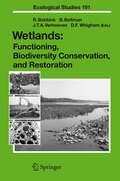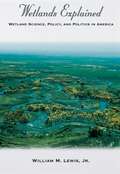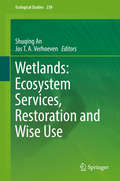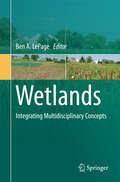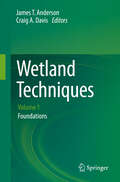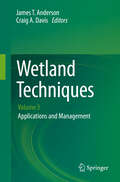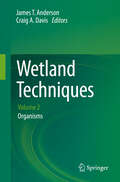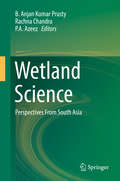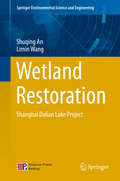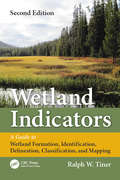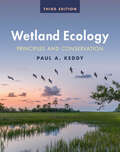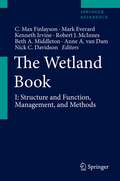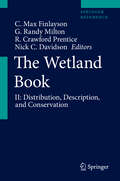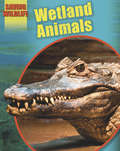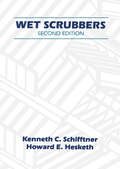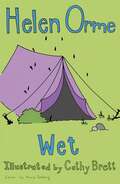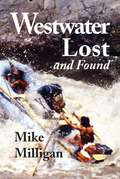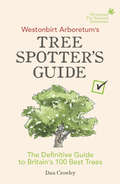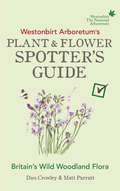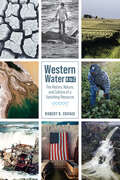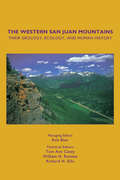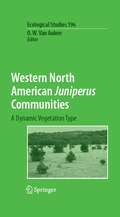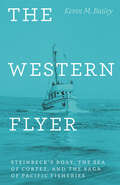- Table View
- List View
Wetlands: Functioning, Biodiversity Conservation, and Restoration (Ecological Studies #191)
by Roland Bobbink Boudewijn Beltman Jos T. A. Verhoeven Dennis F. WhighamThis book gives a broad and well-integrated overview of recent major scientific results in wetland science and their applications in natural resource management. After an introduction into the field, 12 chapters contributed by internationally known experts summarize the state of the art on a multitude of topics. The coverage is divided into three sections: Functioning of Plants and Animals in Wetlands; Conservation and Management of Wetlands; and Wetland Restoration and Creation.
Wetlands Explained: Wetland Science, Policy, and Politics in America
by William M. LewisThis book brings together in compact form a broad scientific and sociopolitical view of US wetlands. This primer lays out the science and policy considerations to help in navigating this branch of science that is so central to conservation policy, ecosystem science and wetland regulation. It gives explanations of the attributes, functions and values of our wetlands and shows how and why public attitudes toward wetlands have changed, and the political, legal, and social conflicts that have developed from legislation intended to stem the rapid losses of wetlands. The book describes the role of wetland science in facilitating the evolution of a rational and defensible system for regulating wetlands and will shed light on many of the problems and possibilities facing those who quest to protect and conserve our wetlands.
Wetlands: Ecosystem Services, Restoration and Wise Use (Ecological Studies #238)
by Shuqing An Jos T. A. VerhoevenThis volume explores major wetland ecosystem services, such as climate cooling and water quality improvement, and discusses the recent wetland conservation and restoration activities in China and neighboring countries. The role of wetlands in either cooling or warming the climate is analyzed as the net balance between carbon sequestration and emissions of methane and nitrous oxide. Wetlands start off having a net warming effect on the climate but in time switch to net cooling. Further, they remove 40% of the N and P from run-off and groundwater flow in agricultural areas, but wetlands need to amount to 10% of the total catchment area to make a difference.Reflecting on the recent large investment in wetland ecological studies in China and neighboring countries, the book addresses invasive species in coastal wetlands as well as the protection and wise use of tidal flats around the Yellow Sea. It also presents promising regional case studies on wetland restoration. The book is intended for academics, students and practitioners in the field of wetland ecology, management and restoration, as well as consultants and professionals working in conservation, wise use and environmental policy.
Wetlands: Integrating Multidisciplinary Concepts
by Ben A. LePageThe science of wetlands and our understanding of these complex ecosystems have improved considerably. The emergence of multidisciplinary strategies is providing new opportunities and innovative approaches to address issues such as climate change and coastal protection. This book, with contributions from 19 specialists from academia, government, and industry, provides a trans-disciplinary approach to the understanding wetlands science, drawing together a wide range of expertise. Topics covered include the physical aspects that shape different wetlands around the world, as well as wetlands ecology, regulation, policy, and related social and economic issues.Featuring contributions from some of the world’s leading wetlands researchers and practitioners, this book provides an invaluable resource for undergraduate and post-graduate training in all aspects of wetlands management, conservation, and construction. It is also a useful auxiliary text for researchers working across disciplines in fields such as wetlands science, law, landscape architecture, environmental engineering, conservation ecology, and related disciplines.
Wetland Techniques: Volume 1: Foundations
by James T. Anderson and Craig A. DavisWetlands serve many important functions and provide numerous ecological services such as clean water, wildlife habitat, nutrient reduction, and flood control. Wetland science is a relatively young discipline but is a rapidly growing field due to an enhanced understanding of the importance of wetlands and the numerous laws and policies that have been developed to protect these areas. This growth is demonstrated by the creation and growth of the Society of Wetland Scientists which was formed in 1980 and now has a membership of 3,500 people. It is also illustrated by the existence of 2 journals (Wetlands and Wetlands Ecology and Management) devoted entirely to wetlands.To date there has been no practical, comprehensive techniques book centered on wetlands, and written for wetland researchers, students, and managers. This techniques book aims to fill that gap. It is designed to provide an overview of the various methods that have been used or developed by researchers and practitioners to study, monitor, manage, or create wetlands. Including many methods usually found only in the peer-reviewed or gray literature, this 3-volume set fills a major niche for all professionals dealing with wetlands.
Wetland Techniques: Volume 3: Applications and Management
by James T. Anderson and Craig A. DavisWetlands serve many important functions and provide numerous ecological services such as clean water, wildlife habitat, nutrient reduction, and flood control. Wetland science is a relatively young discipline but is a rapidly growing field due to an enhanced understanding of the importance of wetlands and the numerous laws and policies that have been developed to protect these areas. This growth is demonstrated by the creation and growth of the Society of Wetland Scientists which was formed in 1980 and now has a membership of 3,500 people. It is also illustrated by the existence of 2 journals (Wetlands and Wetlands Ecology and Management) devoted entirely to wetlands.To date there has been no practical, comprehensive techniques book centered on wetlands, and written for wetland researchers, students, and managers. This techniques book aims to fill that gap. It is designed to provide an overview of the various methods that have been used or developed by researchers and practitioners to study, monitor, manage, or create wetlands. Including many methods usually found only in the peer-reviewed or gray literature, this 3-volume set fills a major niche for all professionals dealing with wetlands.
Wetland Techniques: Volume 2: Organisms
by James T. Anderson and Craig A. DavisWetlands serve many important functions and provide numerous ecological services such as clean water, wildlife habitat, nutrient reduction, and flood control. Wetland science is a relatively young discipline but is a rapidly growing field due to an enhanced understanding of the importance of wetlands and the numerous laws and policies that have been developed to protect these areas. This growth is demonstrated by the creation and growth of the Society of Wetland Scientists which was formed in 1980 and now has a membership of 3,500 people. It is also illustrated by the existence of 2 journals (Wetlands and Wetlands Ecology and Management) devoted entirely to wetlands.To date there has been no practical, comprehensive techniques book centered on wetlands, and written for wetland researchers, students, and managers. This techniques book aims to fill that gap. It is designed to provide an overview of the various methods that have been used or developed by researchers and practitioners to study, monitor, manage, or create wetlands. Including many methods usually found only in the peer-reviewed or gray literature, this 3-volume set fills a major niche for all professionals dealing with wetlands.
Wetland Science: Perspectives From South Asia
by B. Anjan Prusty Rachna Chandra P. A. AzeezThis book is an attempt to acknowledge the discipline ‘wetland science’ and to consolidate research findings, reviews and synthesis articles on different aspects of the wetlands in South Asia. The book presents 30 chapters by an international mix of experts in the field, who highlight and discuss diverse issues concerning wetlands in South Asia as case studies. The chapters are divided into different themes that represent broad issues of concern in a systematic manner keeping in mind students, researchers and general readers at large. The book introduces readers to the basics and theory of wetland science, supplemented by case studies and examples from the region. It also offers a valuable resource for graduate students and researchers in allied fields such as environmental studies, limnology, wildlife biology, aquatic biology, marine biology, and landscape ecology.To date the interdisciplinary field ‘wetland science’ is still rarely treated as a distinct discipline in its own right. Further, courses on wetland science aren’t taught at any of the world’s most prestigious universities; instead, the topics falling under this discipline are generally handled under the disciplines ‘ecology’ or under the extremely broad heading of ‘environmental studies’. It is high time that ‘Wetland Science’ be acknowledged as an interdisciplinary sub-discipline, which calls for an attempt to consolidate its various subtopics and present them comprehensively. Thus, this book also serves as a reference base on wetlands and facilitates further discussions on specific issues involved in safeguarding a sustainable future for the wetland habitats of this region.
Wetland Restoration: Shanghai Dalian Lake Project (Springer Environmental Science and Engineering #238)
by Shuqing An Limin Wang“Wetland Restoration: Shanghai Dalian Lake Project” introduces the whole Shanghai DaLian wetland restoration project, including the background investigation of the wetland, the overall planning of wetland restoration, its detailed design, engineering construction and engineering effects. This book appeals to readers especially due to its detailed data on wetland restoration. Readers can carry out a similar project step by step from the initial investigation to the last assessment by following the structure presented in this work. Through this book, we can get first-hand information on a wetland restoration, but it can also be valuable for other projects.Professor Shuqing An works at Nanjing University, China.
Wetland Indicators: A Guide to Wetland Formation, Identification, Delineation, Classification, and Mapping, Second Edition
by Ralph W. TinerUnderstand the current concept of wetland and methods for identifying, describing, classifying, and delineating wetlands in the United States with Wetland Indicators - capturing the current state of science's role in wetland recognition and mapping.Environmental scientists and others involved with wetland regulations can strengthen their knowledge about wetlands, and the use of various indicators, to support their decisions on difficult wetland determinations. Professor Tiner primarily focuses on plants, soils, and other signs of wetland hydrology in the soil, or on the surface of wetlands in his discussion of Wetland Indicators.Practicing - and aspiring - wetland delineators alike will appreciate Wetland Indicators' critical insight into the development and significance of hydrophytic vegetation, hydric soils, and other factors. Features Color images throughout illustrate wetland indicators. Incorporates analysis and coverage of the latest Army Corps of Engineers delineation manual. Provides over 60 tables, including extensive tables of U.S. wetland plant communities and examples for determining hydrophytic vegetation.
Wetland Indicators: A Guide to Wetland Formation, Identification, Delineation, Classification, and Mapping, Second Edition
by Ralph W. TinerUnderstand the current concept of wetland and methods for identifying, describing, classifying, and delineating wetlands in the United States with Wetland Indicators - capturing the current state of science's role in wetland recognition and mapping.Environmental scientists and others involved with wetland regulations can strengthen their knowledge about wetlands, and the use of various indicators, to support their decisions on difficult wetland determinations. Professor Tiner primarily focuses on plants, soils, and other signs of wetland hydrology in the soil, or on the surface of wetlands in his discussion of Wetland Indicators.Practicing - and aspiring - wetland delineators alike will appreciate Wetland Indicators' critical insight into the development and significance of hydrophytic vegetation, hydric soils, and other factors. Features Color images throughout illustrate wetland indicators. Incorporates analysis and coverage of the latest Army Corps of Engineers delineation manual. Provides over 60 tables, including extensive tables of U.S. wetland plant communities and examples for determining hydrophytic vegetation.
The Wetland Book: I: Structure And Function, Management, And Methods
by C. Max Finlayson Mark Everard Kenneth Irvine Robert J. McInnes Beth A. Middleton Anne A. van Dam Nick C. DavidsonThe Wetland Book: Ii: Distribution, Description, And Conservation
by C. Max Finlayson G. Randy Milton R. Crawford Prentice Nick C. DavidsonWetland Animals: Wetland Animals (library Ebook) (Saving Wildlife)
by Sonya NewlandWetland Animals investigates how people are working to save one of our most important ecosystems, and the millions of animals that rely on the world's wetlands for survival.It is part of the Saving Wildlife series, which investigates the world's endangered species in the context of their different environments.
Wet Scrubbers
by Howard D. HeskethA basic technical book on the design and application of gas cleaning technologies that use liquids, first published in the 1980's and used by plant and environmental engineers, regulatory personnel, and others concerned with air pollution. The second edition enlarges the discussion on the theory of
Wet Scrubbers
by Howard D. HeskethA basic technical book on the design and application of gas cleaning technologies that use liquids, first published in the 1980's and used by plant and environmental engineers, regulatory personnel, and others concerned with air pollution. The second edition enlarges the discussion on the theory of
Wet!: Set Two (Sitis Sisters Ser.)
by Helen OrmeKelly and Lu are on a camping trip when there is a serious accident.
Westwater Lost and Found
by Mike MilliganIn this heavily illustrated book, Mike Milligan has captured the still developing story of one of those remote, but no longer secluded, corners of the Colorado Plateau. Upstream from Moab on the Colorado River, near the Colorado state line, there is a relatively short, deep canyon that has become one of the most popular river-running destinations in America. The canyon is known as Westwater. Its popularity is largely due to the thrill provided by one of the most dangerous and challenging stretches of white water on the Colorado---Skull Rapid. Near the head of the canyon are the remnants of the tiny town of Westwater, which has had an interesting and eventful history of its own, partly because of the river and canyon, partly because of the railroad that passes through it, and partly because of its remoteness. It has attracted over the years more than its fair share of colorful characters---government explorers and agents, boosters and get-rich-quick dreamers, cattle and sheep men, outlaws and bootleggers, and, of course, river runners. Mike Milligan, who came to know the area as a river guide, has written a thorough history of this out-of-the-way place. While it has a colorful history that makes its story interesting in and of itself, Westwater's significance derives more from a phenomenon of the modern West-thousands of recreational river runners. They have pushed a backwater place into the foreground of modern popular culture in the West. Westwater seems to represent one common sequence in western history: the late opening of unexplored territories; sporadic, often unsuccessful attempts to develop them; renewed obscurity when development doesn't succeed; their attraction of a marginal society of misfits or loners; and modern rediscovery due to new cultural motives, especially outdoors recreation, which has brought a great number of people into thousands of remote corners of the West.
Westonbirt Arboretum’s Tree Spotter’s Guide: The Definitive Guide to Britain’s 100 Best Trees
by Dan CrowleyIn the depths of the Cotswolds, near Tetbury in Gloucestershire, lies one of the most beautiful tree gardens in the world, known as Westonbirt Arboretum. Here you can find around 15,000 trees, each one lovingly labelled. They offer the perfect, picturesque setting for escaping from the pressures of everyday life.Now, for the first time, 100 of the most popular British trees form the basis of this beautiful pocket guide. Illustrated with artwork depicting the tree and leaf, this covetable little book will educate and entertain with wonderfully concise text by one of the world’s leading tree experts from the Arboretum. Pop this book in your pocket for a great day out spotting some of the most celebrated features of our landscape!
Westonbirt Arboretum’s Plant and Flower Spotter’s Guide
by Dan Crowley Matt ParrattGet back to nature with this easy to use guide to Britain's greenery. From the experts at Westonbirt Arboretum in the depths of the Cotswolds, with one of the most beautiful gardens in the world, comes this beautiful pocket guide covering 100 popular wild plants and flowers.Categorised by type of plant, the simple layout ensures that this text is easy to use ‘on the go’. Meadow Saffron, Sweet Woodruff and Solomon’s Seal are just a few examples of the vibrant entries - each accompanied by two beautiful images and a short description.Illustrated with enchanting colour artwork, depicting each plant and their individual bloom or sprig, this covetable book will educate and entertain with text by two leading experts from the Arboretum and the Forestry Commission.
Western Water A to Z: The History, Nature, and Culture of a Vanishing Resource
by Robert R. CrifasiWestern Water A to Z is the first ever field guide to Western water. Reinventing this twentieth-century genre for a twenty-first-century audience, Robert R. Crifasi answers questions about rivers, water projects, the culture of water, the ecosystems water projects have created or destroyed, and the reliance of cities, farms, and industries on this critical resource. Organized as a collection of terms, the book addresses the most salient water issues and provides helpful background information regarding their origins and implications. Photographs serve a vital role in the cultural dialogue on water and stand as an equal partner to the text. Each subject is covered in about one page and is accompanied by one or two striking images from famous photographers like Margaret Bourke-White, Carleton E. Watkins, Arthur Rothstein, William Henry Jackson, and Dorothea Lang as well as Crifasi’s own work. Water often finds itself at the center of our cultural discourse in art, cinema, and literature, which play essential roles in shaping our understanding and experience of Western water. Crifasi also engages personalities that are nearly synonymous with Western water—John Wesley Powell, Elwood Mead, and Floyd Dominy, among others—to show how their lives intertwined with and often influenced the course of water development across the region. Travelers, adventurers, students, and anyone interested in water will find Western Water A to Z a handy and entertaining reference guide.
The Western San Juan Mountains: Their Geology, Ecology, and Human History
by Rob Blair Tom Ann Casey William H. Romme Richard N. EllisThe San Juan Skyway winds its way up, over, and through canyons, mesas, plateaus, mountains, plains, and valleys. The sheer variety of landforms makes the Skyway a veritable classroom for the amateur naturalist and historian. The most complete work published on the natural history of southwest Colorado's majestic mountain system, The Western San Juan Mountains: Their Geology, Ecology, and Human History is designed to be used while exploring the scenic 235-mile paved San Juan Skyway, which passes through Durango, Silverton, Ouray, Telluride, Dolores, and Cortez. The Western San Juan Mountains covers the physical environment, the biological communities, the human history, and points of interest represented on milepost signs along the highway. Some of the many topics covered include: how the San Juan Mountains were formed; why the landscape is so rugged and picturesque; why the vegetation changes from the lowlands to the alpine heights; energy and mineral resources of the area; why these mountains intrigued early explorers; factors that influence the unpredictable weather; and the first-known inhabitants. The contributions to this guide include Fort Lewis College geologists, biologists, archaeologists, historians, and other specialists. Together they have amassed more than one hundred years of study based not only on previous work but on their own research. This generously illustrated guidebook is aimed at all those who wish to understand this intricate mountain system in much greater detail than provided by most picture books.
Western North American Juniperus Communities: A Dynamic Vegetation Type (Ecological Studies #196)
by Oscar Van AukenIn North America, Juniperus woodlands occupy approximately 55 million hectares, an area larger than the state of Texas. This title addresses various aspects of the biology, ecology, and management of Juniperus woodlands and savannas, synthesizing past and current research findings as well as proposed research. The book provides ecologists, land managers, and foresters with a solid foundation in Juniperus ecosystems, enabling them to manage the communities for maximum sustained productivity and diversity.
The Western Flyer: Steinbeck's Boat, the Sea of Cortez, and the Saga of Pacific Fisheries
by Kevin M. BaileyIn January 2010, the Gemini was moored in the Swinomish Slough on a Native American reservation near Anacortes, Washington. Unbeknownst to almost everyone, the rusted and dilapidated boat was in fact the most famous fishing vessel ever to have sailed: the original Western Flyer, immortalized in John Steinbeck’s nonfiction classic The Log from the Sea of Cortez. In this book, Kevin M. Bailey resurrects this forgotten witness to the changing tides of Pacific fisheries. He draws on the Steinbeck archives, interviews with family members of crew, and more than three decades of working in Pacific Northwest fisheries to trace the depletion of marine life through the voyages of a single ship. After Steinbeck and his friend Ed Ricketts—a pioneer in the study of the West Coast’s diverse sea life and the inspiration behind “Doc” in Cannery Row—chartered the boat for their now-famous 1940 expedition, the Western Flyer returned to its life as a sardine seiner in California. But when the sardine fishery in Monterey collapsed, the boat moved on: fishing for Pacific ocean perch off Washington, king crab in the Bering Sea off Alaska, and finally wild Pacific salmon—all industries that would also face collapse. As the Western Flyer herself faces an uncertain future—a businessman has bought her, intending to bring the boat to Salinas, California, and turn it into a restaurant feature just blocks from Steinbeck’s grave—debates about the status of the California sardine, and of West Coast fisheries generally, have resurfaced. A compelling and timely tale of a boat and the people it carried, of fisheries exploited, and of fortunes won and lost, The Western Flyer is environmental history at its best: a journey through time and across the sea, charting the ebb and flow of the cobalt waters of the Pacific coast.
